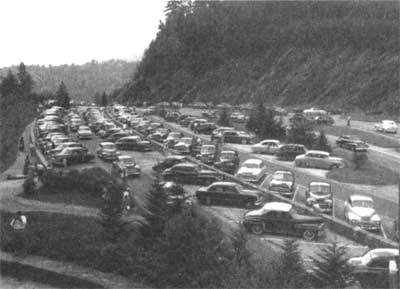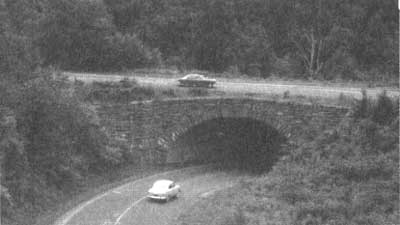 | ||
 | ||
 | ||
 | ||
 | ||
 | ||
 | ||
 | ||
 | ||
 | ||
 | ||
 | ||
 | ||
 | ||
 | ||
 | ||
 | ||
 |
 |
 |
Great Smoky Mountains National Park
North Carolina, Tennessee
SCENIC MOTORWAYS AND NEWFOUND GAP ROAD
In 1926 the National Park Service entered into a cooperative agreement with the Department of Agriculture's Bureau of Public Roads (BPR), to develop a systematic approach for future road building in the national parks. Under this agreement, BPR engineers provided technical expertise for road construction while Park Service landscape designers ensured the roads' aesthetic qualities. The result was a naturalistic method of construction, often called "rustic," that involved the careful positioning of road alignments in relationship to natural topography and scenery and minimizing scars caused by construction. Such an approach ideally suited the needs of park road designers, making it possible for them to uphold the twofold policy of the National Park Service: to provide public access to national parks while preserving their resources and scenery.

View of the Newfound Gap Parking Area from Rockefeller Memorial, 1952. (Rowe) |
Although the Park Service constructed several mountain roads during the early 1930s in eastern parks such as Skyline Drive in Shenandoah and Cadillac Mountain Road in Acadia, none posed the technical challenges of Newfound Gap Road in the Smokies. BPR engineers reconstructed large portions of the existing road, originally built during the 1920s by Tennessee and North Carolina, to make it safer for motorists. For instance, to eliminate sharp curves and steep grades the Bureau constructed a loop-over structure in 1934 to replace two switchbacks, and added a second tunnel and several bridges in 1936.

A popular tourist attraction in itself the Loop Over on Newfound Gap Road replaced a dangerous switchback. (GRSM, 1950s) |
As important as the technical improvements made by Bureau engineers to Newfound Gap Road were the aesthetic changes undertaken by the National Park Service's landscape designers. In general such changes took two forms. First, the road was reconstructed so as to provide motor tourists with even better access to the Park's breathtaking mountain scenery. Park Service landscape architects accomplished this through a variety of means, the most important of which was the scenic parking area or overlook. The second set of scenic improvements were aimed at making Newfound Gap Road itself more aesthetically pleasing. By using native construction materials and extensively landscaping road cuts and shoulders with native flora, the Park Service was able to blend Newfound Gap Road in with its natural surroundings.
| Introduction | Acadia | Blue Ridge Parkway | Chickamauga and Chattanooga | Colonial Parkway | Generals Highway | George Washington Memorial Parkway | Great Smoky Mountains | Mount Rainier | Rock Creek and Potomac Parkway | Shenandoah's Skyline Drive | Southwest Circle Tour | Vicksburg | Yellowstone | Yosemite |
